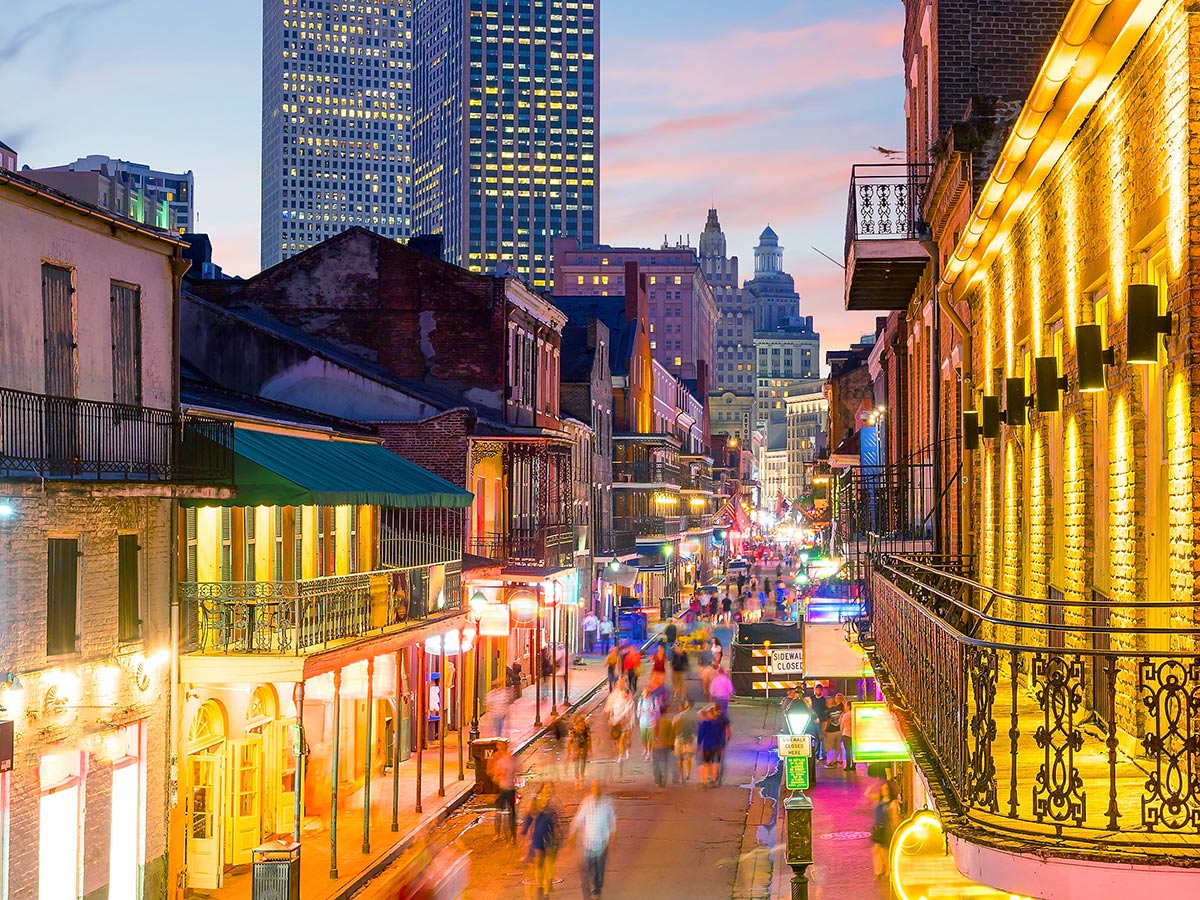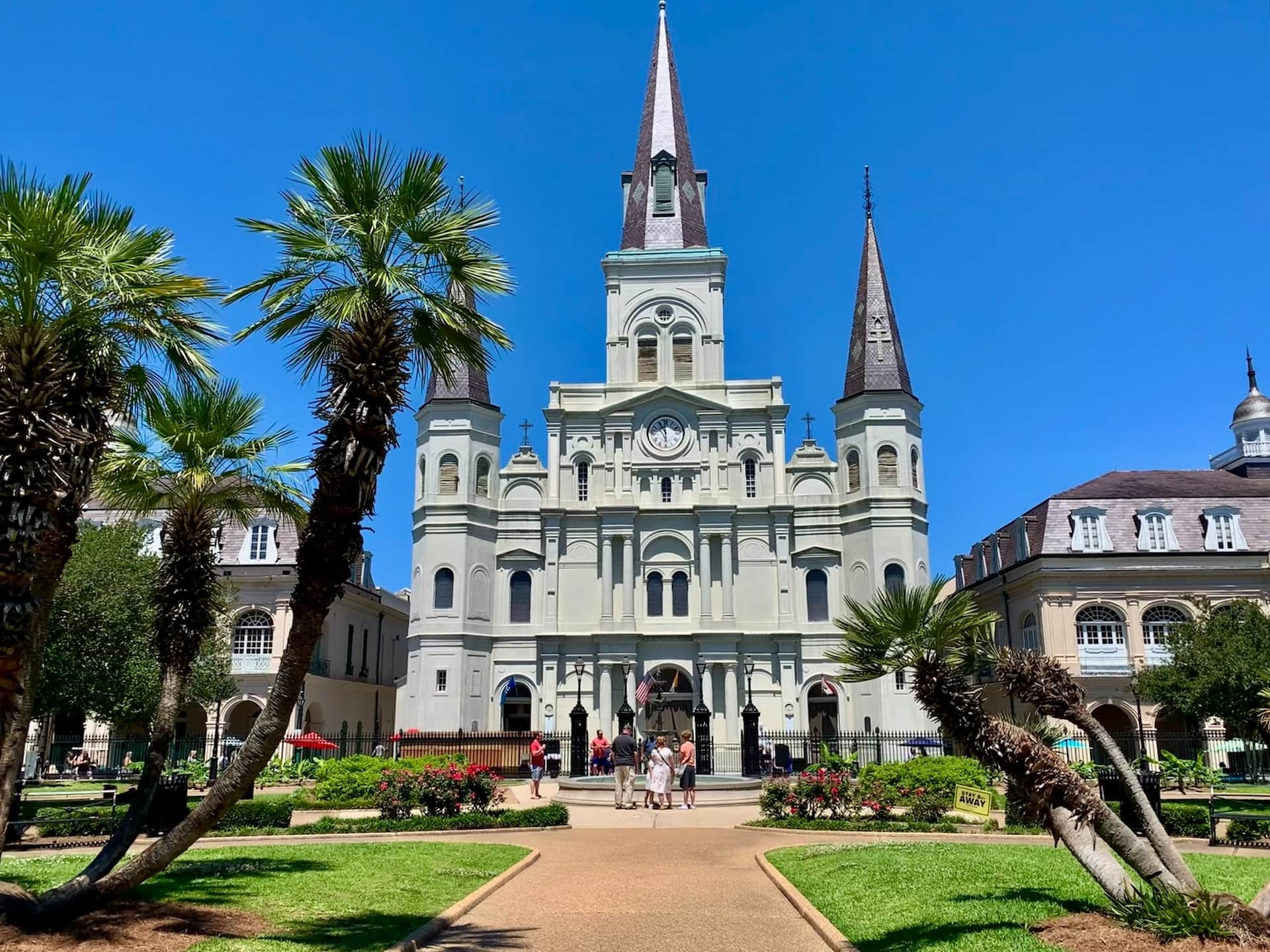With a particular atmosphere and laid-back attitude, New Orleans is one of the most unique cities in the United States. The crescent city given its shape, also called NOLA, is a stimulating city that, although small in size, knows how to make tourists pass the time but above all knows how to entertain its inhabitants.
Known worldwide for jazz music, Cajun cuisine, picturesque Mardi Gras celebrations, the surrounding countryside, and its history as glorious as it is inauspicious, the city is a melting pot of different cultures that pour in and tell each other in every single aspect. citizens, from music to food and architecture.
15. Sample the Unique Local Fare

(images via David Todd McCarty and Jessica Tan)
There are several dishes that are distinctive to their region, and New Orleans is among the best. Classic Creole and Cajun delicacies like gumbo, po’boys, and their famed crawfish may be found here. Café Du Monde‘s assemblage of oysters and beignets will warm you from head to toe. Their coffee is supplied locally, so you may try it and even take some home with you.
Stop by the Commander’s Palace for sophisticated Creole dishes and an elegant jazz brunch in a chandelier-hung setting. In the afternoon try the stylishly remodeled warehouse location known as GW Fins. This hot spot offers an innovative, ever-changing seafood lineup utilizing fresh catches. When your day is done, stop into Mr. B’s Bistro for some Gumbo ya ya, a delicious country-style gumbo cooked with chicken and authentic andouille sausage.
14. Saint Louis Cemetery

For hundreds of years, Louisiana has been afflicted with massive floods, and no location exemplifies this more than the Saint Louis Cemetery. This designation is given to three separate Catholic cemeteries, Nos. 1, 2, and 3. The majority of the burials are above-ground stone vaults built in the 18th and 19th centuries. Cemeteries No. 1 and No. 2 are included on the National Register of Historic Places and the Louisiana African American Heritage Trail. Above-ground mausoleums, tombs, and gravestones can be found in these historic resting places.
Whatever your reason, a journey to New Orleans would be incomplete without a visit to St. Louis Cemetery. Due to vandals, St. Louis Cemetery No. 1 is only accessible via guided, permitted tours, unlike most other New Orleans cemeteries. During the journey, you will learn about the region’s voodoo gurus, artists, and great philosophers. As it is an active cemetery site, you may possibly encounter some of their descendants.
13. Experience Some Live Music

Jazz, music that transcends language, brings this city to life. Frenchmen Street is located in New Orleans’ 7th Ward. It is primarily known for a three-block stretch in the Faubourg Marigny area, which houses some of the city’s most prominent live-music establishments. At Preservation Hall, a historic, all-ages jazz venue with wooden flooring, you’ll find an authentic New Orleans jazz atmosphere.
If you’re searching for something a little more upbeat, check out The Spotted Cat Music Club. This intimate jazz venue features live performers on a tiny stage for a standing-room-only audience.
12. The Historic New Orleans Collection

(image via The Historic New Orleans Collection)
The Historic New Orleans Collection is a collection made up of houses that are architectural treasures of the French Quarter and that were restored to open to the public. In this collection are:
Merieult House
It is a colonial house from the 18th century that was the headquarters and headquarters of the forges of the King of France. It currently houses the Louisiana History Gallery and the Williams Gallery.
Williams Residence
It was built in 1889 and is a 2 story Italian-style house with galleries. It belonged to Kemper and Leila Williams and preserves the 1940s and 1950s décor that the couple put up.
11. Tour Former Cotton Plantations

(image via Whitney Plantation)
Cotton gave New Orleans so much wealth that during its heyday there were more millionaires in the city than in any other American town.
A tour of the old plantations, along River Road, will transport you to the days before the Civil War, when whites lived happily in their beautiful mansions surrounded by cotton fields, with a large servitude of African Americans.
There are many plantations open to tourism, a short drive from New Orleans, such as Laura Plantation, Houma House and Gardens, Oak Plantation, Nottoway Plantation, San Francisco Plantation, and Whitney Plantation.
The superb mansions on these plantations are part of Louisiana’s cultural heritage, and some feature restaurants and accommodations to provide a more complete “Gone with the Wind experience.”
10. New Orleans Museum of Art

(image via New Orleans Museum of Art)
Isaac Delgado was a prosperous New Orleans sugar businessman who donated $ 150,000 in 1910 to help the city have what he called “a temple of art for rich and poor alike.”
The institution opened in 1911 with nine works and today it houses a valuable and impressive collection of over 40,000 pieces. The NOMA is located in City Park, near the intersection of Carrollton and Esplanade avenues.
It encompasses European art from the Renaissance and American art from the 18th century, as well as pre-Columbian, Asian, African, and oceanic works.
One of its sites that has become iconic in the city is the Sydney Sculpture Garden and Walda Besthoff. The Rosemonde and Emile Kuntz Halls display an exceptional New Orleans decorative and artistic heritage.
The NOMA is known for its collection of great European and American masters, including Monet, Degas, Renoir, Matisse, Picasso, Gauguin, Pollock, Georgia O’Keeffe, and Mary Cassatt.
9. Audubon Butterfly Farm and Insectary

(image via Lenstravelier)
It is the largest museum on the planet dedicated to insects. It operates in a building that was the customs office of the port of New Orleans between 1840 and 1881. It is located on Canal Street 423.
It has more than 50 live exhibitions and various multimedia aids in an area of 2,100m2 and some of its samples are:
Metamorphosis Gallery
Here you will see the insects go from larvae to pupae to adults.
Hall of Fame
Preserved specimens of the most impressive insects in the world.
Bug Appétit
Here you can watch the chefs prepare dishes with insects and taste them.
Termite Gallery
Here you can see what these insects are capable of doing to wood.
Butterfly Garden
It is a space with hundreds of living specimens of these beautiful insects.
8. Mardi Gras World

(image via Mardi Gras World)
At Mardi Gras World guests are given a tour of the 300,000-square-foot operating warehouse where floats for New Orleans’ Mardi Gras parades are created. This venue provides a genuine Mardi Gras experience all year, whether you’re in town for a family vacation, team building activities, or to visit New Orleans. More than 80% of the floats that parade through New Orleans’ streets during Carnival season are planned and produced here.
This globally unique spot allows guests to dress in traditional Mardi Gras costumes and tour massive warehouses filled with floats. During the tour, guests learn about the myriad of traditions associated with Mardi Gras parades, balls, and music, as well as the complexities of float design and construction. Visit Mardi Gras World, the world’s largest float designing and constructing factory, to experience Mardi Gras all year.
7. New Orleans Jazz Museum

(image via New Orleans Jazz Museum)
The musical genre known as jazz was born in New Orleans in the second half of the 19th century, although the word “jazz” to identify it was first written several decades later, in 1913.
It houses the world’s largest collection of jazz-related objects, including the first recording made in 1917, Louis Armstrong’s first cornet, and instruments that belonged to famous jazz players, such as Dizzy Gillespie, Bix Beiderbecke, Edward “Kid” Ory, Sidney Bechet and George Lewis.
The museum’s collection includes 12,000 photographs, 4,000 discs in different formats (78, 45, and 33 RPM), original scores, and films from famous jazz cabarets, festivals, parades, and funerals, a Louisiana tradition.
6. The Presbytère

(image via Infrogmation)
It houses a display of objects related to Mardi Gras, one of the main traditions of New Orleans.
The exhibit called “Mardi Gras: It’s Carnival Time in Louisiana” takes a tour of this celebration from its origins to the present day, enriching it with the dances and parades that have made New Orleans Carnival famous.
In the interactive exhibits, visitors can experience the thrill of the parades and ride a carnival float.
5. Aquarium of the Americas

(image via Audobon Nature Institute)
The prestigious Audubon Aquarium is located on Channel Street 1, next to the Mississippi River. It houses not less than 15,000 creatures of 600 different species that have charming habitats in these state-of-the-art facilities.
There is a gallery dedicated to seahorses, where you can admire how these beautiful and curious animals swim, characterized by the fact that it is the male that gives birth.
One of the rare and endangered species is the white, steel-blue-eyed alligator, which comes from the swamps of Louisiana.
In the shark pool, you can touch a baby shark, while an aquarium specialist provides information on the habits of these cartilaginous fish.
Other species that you will see are sea otters, penguins and harmless frogs. The exhibition on the Amazon rainforest includes poisonous frogs, anacondas and exotic birds. The Caribbean Reef Tunnel offers views of marine life only available to divers.
4. Party At A Festival

It is a festival that has been held since 1970, dedicated to the main music of New Orleans and other indigenous cultural manifestations of the city. It takes place between the end of April and the beginning of May and its main stage is the Fair Grounds Race Course, a racetrack located in downtown New Orleans.
Apart from the different manifestations of jazz (traditional, contemporary, swing, bebop and others), the festival covers all genres and musical styles related to New Orleans and Louisiana, including blues, folk, rock, gospel, R&B, Cajun, Latin, rap, country and other rhythms.
After the musical, the most important facet of the festival is gastronomic and it is the occasion to taste some of the culinary specialities of the city and the state, such as the po-boy sandwich, the jambalaya, the fried green tomatoes, the crab beignets, the oyster patties and the crab Monica. A remarkable aspect of the festival is the large spaces destined to make known the history and the Louisiana cultural features.
This festival, which began in 1984, was conceived to remind New Yorkers, Americans, and foreign tourists how beautiful, fun, and fabulous the French Quarter is. Every year for four days chained during the second weekend of April, the most important neighborhood in New Orleans is filled with music, color, and gastronomic samples from Jackson Square to all its confines.
The musical genre that presides over the festival is jazz, but rock, Latin music, New Orleans funk, zydeco, rhythm and blues (R&B), swing, and other rhythms are also heard. Dozens of artists from New Orleans, Louisiana, and the United States, accompanied by music legends, liven up the long weekend, as the public walks, sees, and hears without having to pay. During the festival, the “World’s Largest Jazz Brunch” takes place in Jackson Square, Woldenberg Riverfront Park, and its surroundings, so you should go with a good appetite and a little thirst.
3. National WWII Museum

(image via The National WWII Museum)
The National WWII Museum, originally known as The National D-Day Museum, is a military history museum located on Andrew Higgins Drive between Camp Street and Magazine Street in New Orleans. This location has seen approximately two million visitors since its opening day on D-Day, June 6, 2000. It has been designated by the United States Congress as America’s official WWII Museum, making it a must-see for history buffs and patriots alike. The American Spirit, the heroism, teamwork, and sacrifice of the young patriots who won the war and transformed the world, are brought to life via powerful photos and remarkable objects. Visitors may explore America’s involvement in the war and on the Home Front from the 1930s preparation to war, to the Normandy Invasion, and the battles of the Pacific Islands.
Step inside the Museum vault, climb into a Sherman tank and enjoy behind-the-scenes access that you won’t find anywhere. Here guests will be able to touch and feel antiquities and seldom-seen treasures with historians.
2. The French Quarter & Bourbon Street

(image via Rosie Kerr)
In New Orleans, tourism means the French Quarter. The French Quarter and Vieux Carré is the oldest neighborhood in the city. The French Quarter was designated a National Historic Landmark and is the main tourist attraction in New Orleans. Among its great attractions are Jackson Square (Jackson Square), the former Place d’Armes of the French and Plaza de Armas of the Spanish, and Bourbon Street, the most famous street in New Orleans.
Canal Street is one of the most iconic streets in New Orleans and embodies the hustle and bustle of downtown. Canal Street is one of the hottest spots for Mardi Gras (Fat Tuesday), the famous parade that takes place on Shrove Tuesday to celebrate the close of the holiday. Other popular parades are those of the Christmas season, with the street illuminated with spectacular lighting systems.
On Canal Street, you will find splendid theatres such as the Saenger, the Orpheum, and the Joy, which present the best live shows in the city. Canal Street is also the place where New Orleans women and men have been going since the 19th century to renovate the closet with fashionable designs. Popular stores and warehouses include Rubenstein, Meyer the Hatter, and The Shops at Canal Place.
It is a colorful and flavorful market that emerged in 1791 as a Native American shopping street, later joined by French and Spanish settlers. The restaurants and outdoor dining stalls attract a large crowd and one of the most popular is the Café du Monde, serving the beignets and cafés au lait that is famous in the city. The Farmers Market Pavilion is a festival of colors where farmers sell their fresh and processed products, including almond pralines, which are a gastronomic symbol of New Orleans.
Bourbon Street is probably the best-known postcard in New Orleans and its famous bars fill up at night. Older ones, like the Old Absinthe House, retain their charming nineteenth-century flair, though the toxic absinthe no longer serves. The first piano duel was held at Pat O’Brien’s Bar and was the site of the invention of the Huracán cocktail. Napoleon House works in a house in which a plan was forged, not executed, to rescue Napoleon from exile on Saint Helena and bring him to La Nouvelle-Orléans.
1. The New Orleans Streetcar & Garden District

One of the essential things to do in New Orleans is to ride its historic streetcar, which opened in 1834 and is the oldest in service in the world. It’s a convenient, glamorous, and inexpensive way to get to know the city, as the streetcar passes through the French Quarter and many other parts of New Orleans. It has the following lines:
Saint Charles Line
Pass through St. Charles and Carrollton avenues, which are symbolic of New Orleans’s romance and charm. This particular line is the oldest continuously operating street tram system in the world—opening as steam-powered and horse-drawn in 1835 and converting to electricity in 1893.
Central Street Line
Pass through the Central Business District, City Park, and the New Orleans Museum of Art.
Summary
As you can see, New Orleans has a lot to offer everyone. If you are looking for more things to do in the surrounding area, check out other weekend trips from nearby New Orleans.
These areas are perfect for a quick day trip or a long weekend getaway. Explore our favorite things to do or peruse some pre-built itineraries.
Fifteen Things to do in New Orleans, Louisiana:
-
New Orleans Cuisine
-
Saint Louis Cemetery
-
Live Music
-
Historic New Orleans Collection
-
Former Plantation Tours
-
New Orleans Museum of Art
-
Audubon Butterfly Farm & Insectary
-
Mardi Gras World
-
New Orleans Jazz Museum
-
The Presbytère
-
Aquarium of the Americas
-
New Orleans Festivals
-
National WWII Museum
-
The French Quarter & Bourbon Street
-
The New Orleans Street Car & Garden District




